This section includes products such as rouges and lipsticks. The text below provides some historical context and shows how we can use these products to explore aspects of American history, for example, the links between changes in American feminine identity and the American beauty industry. To skip the text and go directly to the objects, CLICK HERE
 |
| A shop window advertising sign depicting a pale-complected, red-lipped beauty idealized at the start of the 20th century. Warshaw Collection of Business Americana, Archives Center, National Museum of American History, Smithsonian Institution |
In eighteenth century America, both men and women of the upper classes wore make-up. But, shortly after the American Revolution the use of visible “paint” cosmetics (colored cosmetic for lips, skin, eyes, and nails) by either gender gradually became socially unacceptable. For most of the nineteenth century few paint cosmetics were manufactured in America. Instead, women relied on recipes that circulated among friends, family, and women’s magazines; using these recipes, they discreetly prepared lotions, powders, and skin washes to lighten their complexions and diminish the appearance of blemishes or freckles. Druggists sold ingredients for these recipes, as well as the occasional ready-made preparation. Painting one’s face was considered vulgar and was associated with prostitution, so any product used needed to appear “natural.” Some women secretly stained their lips and cheeks with pigments from petals or berries, or used ashes to darken eyebrows and eyelashes. Woman worked to attain the era’s ideal feminine identity; a “natural” and demure woman with a pale-complexion, rosy lips and cheeks, and bright eyes.
In the 1880s, entrepreneurs began to produce their own lines of cosmetic products that promised to provide a “natural” look for their customers. Some of these new companies were small, woman-owned businesses that typically used an agent system for distribution as pioneered by the California Perfume Company, later rebranded as Avon. This business model allowed many women to make money independently. Also, more women were earning wages and buying cosmetics, thereby enlarging the market further. Women could make a living in the burgeoning cosmetics trade as business owners, agents, or factory workers. Most of these entrepreneurs came from fairly humble origins, and some managed to transform their local operations into successful businesses with a wide distribution of their products. Florence Nightingale Graham, for example, was the daughter of tenant farmers, and worked many low-paying jobs before opening a beauty shop for elite clients and reinventing herself as Elizabeth Arden. African American women also found success through this model, but faced extra obstacles. Many white shop owners refused to consider stocking African American beauty products until successful businesses like that of Madam C. J. Walker created enough of a demand through other distribution channels.
 | 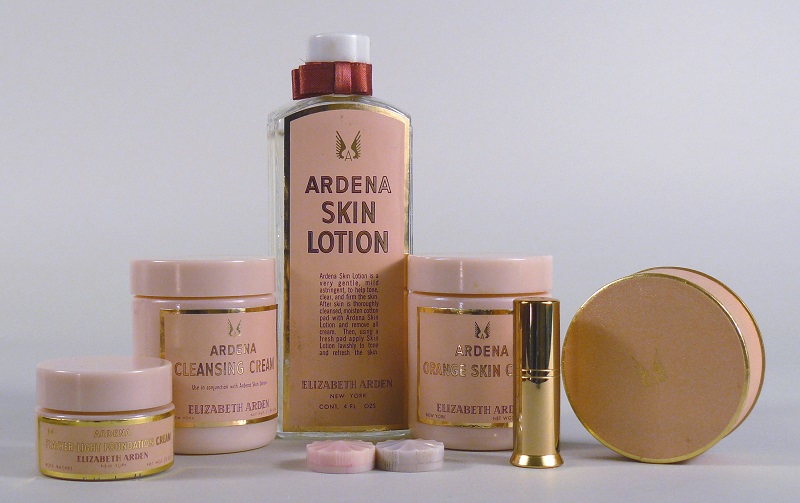 | 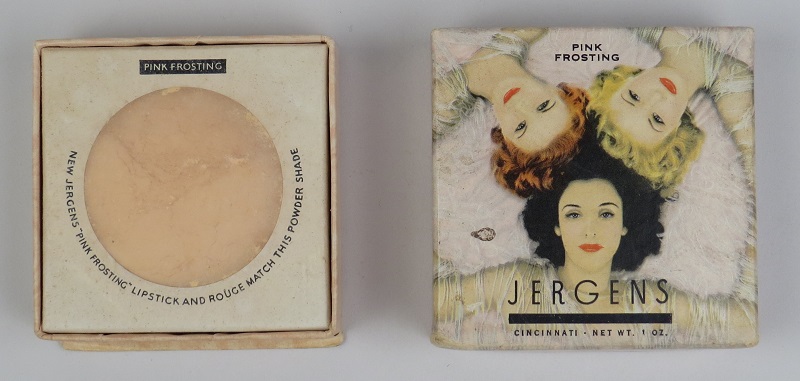 |
| Hi-Hat Jockey Club Face Powder | Elizabeth Arden continued to have "systems" of cosmetics. This one is ca. 1955 | Jergen's Face Powder in Pink Frosting Shade |
By the 1920s, it was fashionable for women, particularly in cities, to wear more conspicuous make-up. This shift reflected the growing influence of Hollywood and its glamourous new film stars, as well as the fashion of theater stars and flappers. “Painted” women could now also identify as respectable women, even as they wore dramatic mascara, eyeliner, dusky eyeshadow, and lipstick like the stars of the screen. The growing ethnic diversity of the United States also influenced how cosmetics companies marketed their products. “Exotic” or “alluring” ethnic stereotypes became inspirations for make-up fashions that ostensibly reflected the American melting pot. White women could experiment with a trendy, exotic identity – and then wash it off. African American identity, however, was explicitly excluded from this ethnic mingling. In the late 1920s and 1930s, it became fashionable for white women to sport the appearance of a “healthy” tan. Previously, a tan had been equated with working-class women who performed outdoor labor; now a tan identified a woman as modern and healthy, participating in outdoor recreations and leisure. Make-up colors were marketed in various “suntanned” shades, giving women the option to remove the “tan” whenever they wished to reclaim a fair complexion.
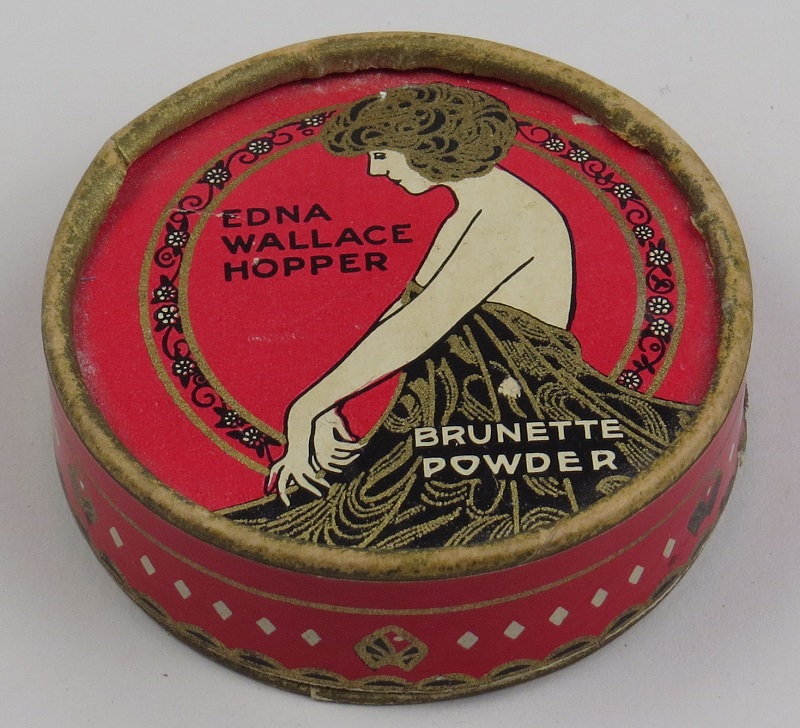 | 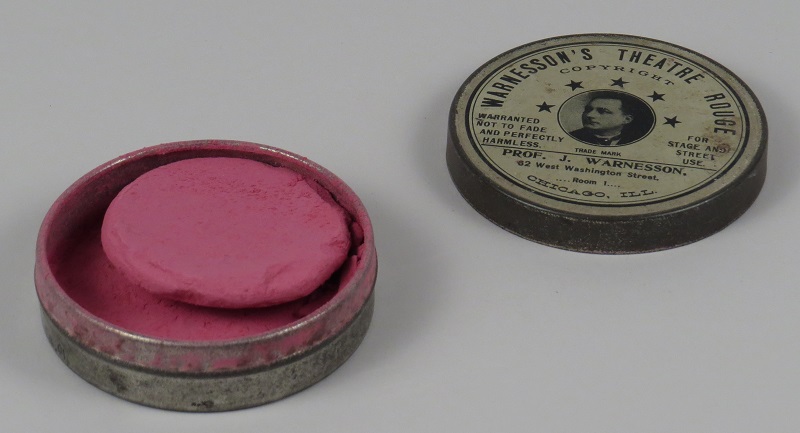 |  |
| Edna Wallace Hopper: "Beauties of the stage and screen use it" | Warnesson's Theatre Rouge - "For Stage and Street" | Outdoor Girl - the Olive Oil Face Powder |
At this time, the cosmetics business experienced a major shift. Small cosmetics companies, many of which were owned by women, were replaced by larger corporations. Business models had changed: in order to remain competitive and achieve wide distribution, a business had to engage in wholesale bargaining with male-owned chain drug and department stores. Because women were usually excluded from these distribution channels, most female-owned businesses could not compete. By 1930, a small handful of companies controlled 40% of the cosmetics industry. These companies now released thousands of factory-produced, similar products under various brand names.
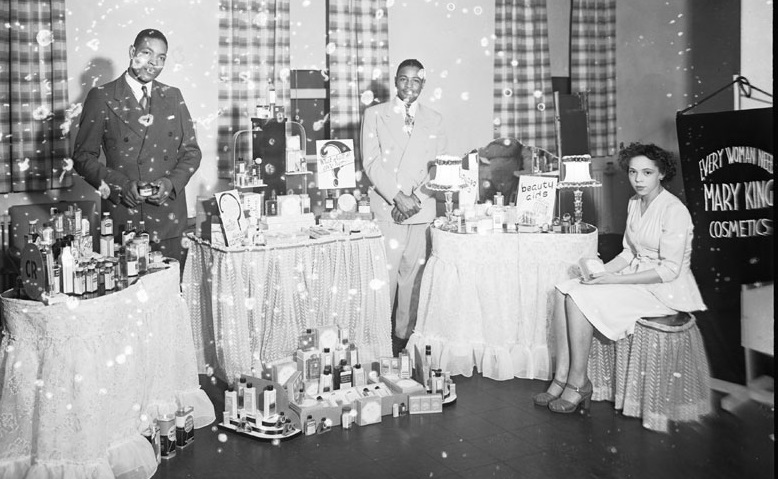 |
| 1930: The J.R. Watkins Company owned the Mary King Cosmetics line. Here, agents sell Watkins products and Mary King cosmetics. Scurlock Studio Records, Archives Center, National Museum of American History, Smithsonian Institution |
Spending on cosmetics increased dramatically when millions of women entered the workforce during the Second World War, gaining greater independence and purchasing power. Younger women embraced an overtly flirtatious persona, signaled through the conspicuous use of bold rouge, powder, lipstick, and nail polish. Many working women wore shorter, more “manly” hair styles, and make-up was used to reassert femininity. When nylon stockings became unavailable because of war-time commodity shortages, women turned to leg make-up—paint-on hosiery maintained the illusion of nylon-clad legs. Cosmetics advertisements and armed forces recruiting campaigns during the war emphasized women’s dual responsibilities: support the war effort and maintain one’s feminine identity through the use of make-up. Government-produced posters encouraging women to join the war effort depicted female nurses and factory workers in bright red lipstick and dark mascara. Makeup, especially lipstick, had become such an essential component of American femininity, that the federal government quickly rescinded its wartime materials-rationing restrictions on cosmetics manufacturers in order to encourage use of make-up. As Kathy Peiss writes in “Hope in a Jar,” the use of make-up had become “an assertion of American national identity.”
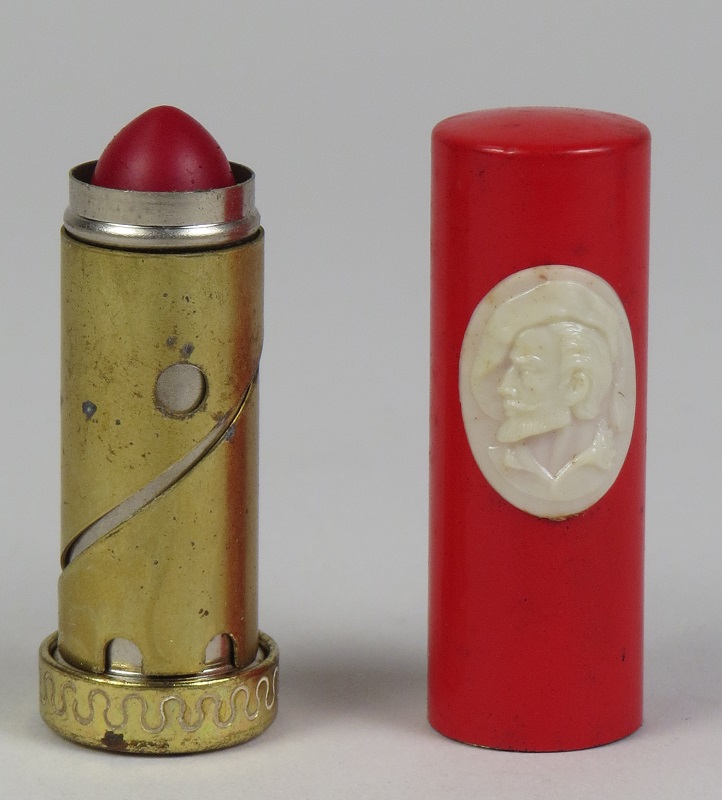 |  | 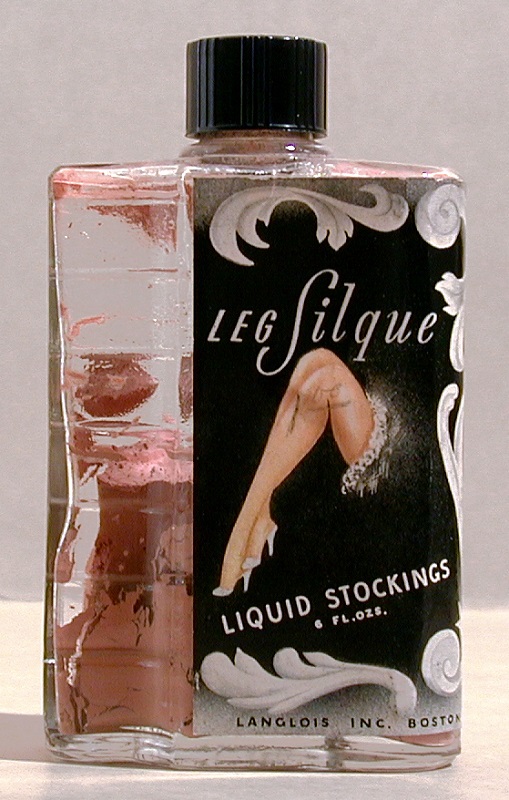 |
| Don Juan Lipstick in the shade #6 Dark Red | WWII recruiting poster. UNT Digital Library, "Ruzzie Green. You are needed now : Join the Army Nurse Corps : Apply at your Red Cross recruiting station. | Leg Silque Liquid Stockings |
After the war, 80-90% of American women wore lipstick, and companies like Avon and Revlon capitalized on this now-ingrained fashion. By the 1950s and 1960s, teenage girls were commonly wearing make-up and cosmetic companies devised separate marketing campaigns to target the younger age groups.
In the late 1960s, using makeup became politicized. Counter-cultural movements celebrated ideals of natural beauty, including a rejection of make-up altogether. Cosmetics companies returned to advertisements that claimed that their products provided a “natural” look. These ideals still relied on racial whiteness as the basis of feminine beauty, but under continued pressure from women of color, major cosmetics firms began to cater to the African American market, not only by producing products geared toward black women (often under separate brands), but also by hiring black women as sales agents. However, the so-called “ethnic” segment of the cosmetic market remained small, making up only 2.3% of total sales in 1977.
 |
| 1977 Revlon advertising campaign for the "Polished Ambers collection...an exciting collection for black women." Revlon Advertising Collection, Archives Center, National Museum of American History, Smithsonian Institution |
Bibliography ~ see the Bibliography Section for a full list of the references used in the making if this Object Group. However, the Make-up section relied on the following references:
Gill, Tiffany M. Beauty Shop Politics: African American Women’s Activism in the Beauty Industry. Urbana; Chicago: University of Illinois Press, 2010.
Jones, Geoffrey. Beauty Imagined: A History of the Global Beauty Industry. Oxford; New York: Oxford University Press, 2010.
Jones, Geoffrey. “Blonde and Blue-eyed? Globalizing Beauty, c.1945–c.19801.” The Economic History Review 61, no. 1 (February 1, 2008): 125–54. doi:10.1111/j.1468-0289.2007.00388.x.
Morris, Edwin T. Fragrance: The Story of Perfume from Cleopatra to Chanel. New York: Scribner, 1984.
Peiss, Kathy Lee. Hope in a Jar: The Making of America’s Beauty Culture. New York: Metropolitan Books, 1998.
Scranton, Philip. Beauty and Business: Commerce, Gender, and Culture in Modern America. New York: Routledge, 2001.












